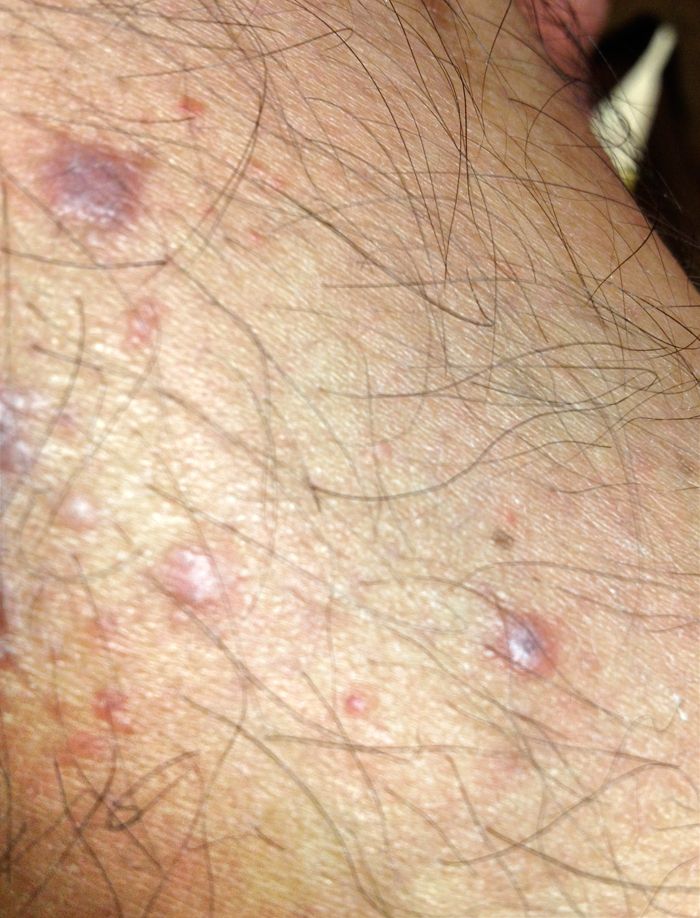Publication
Article
Family Practice Recertification
Dark, Itchy Leg Lesions in a Middle-Aged Man
Author(s):
This 44-year-old man presented to a clinic with multiple dark lesions on his lower extremities. When the lesions first appeared eight months ago, they were slightly raised, pink in color, and intensely itchy, but after repeated excoriation, they have become increasingly dark. The patient reports that a biopsy was inconclusive and creams and an oral medication have not helped his condition. In addition to his leg lesions, there is some involvement of the thigh, buttocks, and penis. He denies any past medical history or other medications. What condition does this man have?
a) Erythema ab igneb) Kaposi’s sarcomac) Lichen planusd) Pyoderma gangrenosume) Syphilis

This patient has lichen planus (LP), which is characterized by the 5 Ps: Purple, Pruritic, Polygonal Papules and Patches. In the photos, you can see the hyperpigmented purple lesions with polygonal shapes, as well as the fine, white-to-gray lines called Wickham’s striae that can also be seen on mucous membrane lesions.
Punch biopsy of one of the active hyperpigmented lesions confirmed the diagnosis, while laboratory test results were negative for HIV, syphilis, and hepatitis C virus (HCV).
Lichen planus is thought to be autoimmune in nature, related to CD8+ T cells with a median diagnostic age of 40 to 45 years old.1 Oral manifestations have a median onset age of around 50 to 60 years old, and as they have the potential for malignant transformation, it's important to examine the oral mucosa. Studies have demonstrated an association between HCV and LP, suggesting that patients with lichen planus should be tested for HCV.2
Left untreated, cutaneous LP typically resolves spontaneously within a year. First-line treatments include high-potency topical steroids like clobetasol applied every night at bedtime with an occlusive dressing for at least six weeks, while second-line treatments comprise 30 mg or 60 mg once-daily prednisone for 6 weeks and oral retinoids.3
In contrast, erythema ab igne presents as a reticulated or net-like pattern of hyperpigmentation in response to repeated exposure to a heat source, such as a wood stove, hot water bottle, or laptop computer. Kaposi’s sarcoma also presents with purple or hyperpigmented lesions, but the condition usually isn’t pruritic, and when it's associated with AIDS, multiple lesions can rapidly progress. Pyoderma gangrenosum affects the lower extremities, but it's ulcerative and most commonly associated with inflammatory bowel disease. Secondary syphilis presents as a generalized exanthema following primary syphilis infection.
References
1. Le Cleach L, Chosidow O. Lichen planus. NEJM. 2012 Feb 23;366(8):723-32. http://tmedweb.tulane.edu/portal/files/open-access/Clerkships/internal-medicine/Ambulatory/Lichen_Planus.pdf.
2. Shengyuan L, Songpo Y, Wen W, Wenjing T, Haitao Z, Binyou W. Hepatitis C virus and lichen planus: A reciprocal association determined by a meta-analysis. Arch Dermatol. 2009 Sep;145(9):1040-7. http://www.rima.org/web/medline_pdf/HepatitisC.pdf.
3. Cribier B, Frances C, Chosidow O. Treatment of lichen planus: An evidence-based medicine analysis of efficacy. Arch Dermatol. 1998 Dec;134(12):1521-30. http://archderm.jamanetwork.com/article.aspx?articleid=189664.
About the Authors

Daniel Stulberg, MD, is Professor of Family and Community Medicine at the University of New Mexico. After completing his training at the University of Michigan, he worked in private practice in rural Arizona before moving into full-time teaching. Stulberg has published multiple articles and presented at many national conferences regarding skin care and treatment. He continues to practice the full spectrum of family medicine with an emphasis on dermatology and procedures.
Stulberg was assisted in writing this article by Rebecca Ryan, MD, a graduate of the University of New Mexico’s Family Medicine Residency Program. She is currently working for the Indian Health Service at the Zuni Indian Hospital in Zuni, NM.





